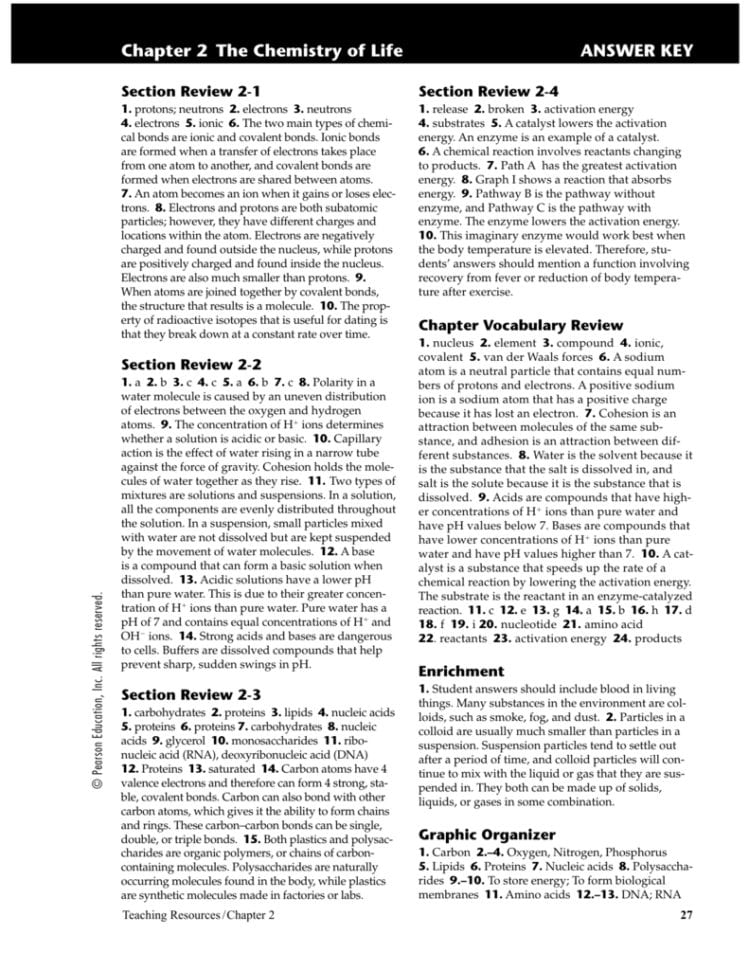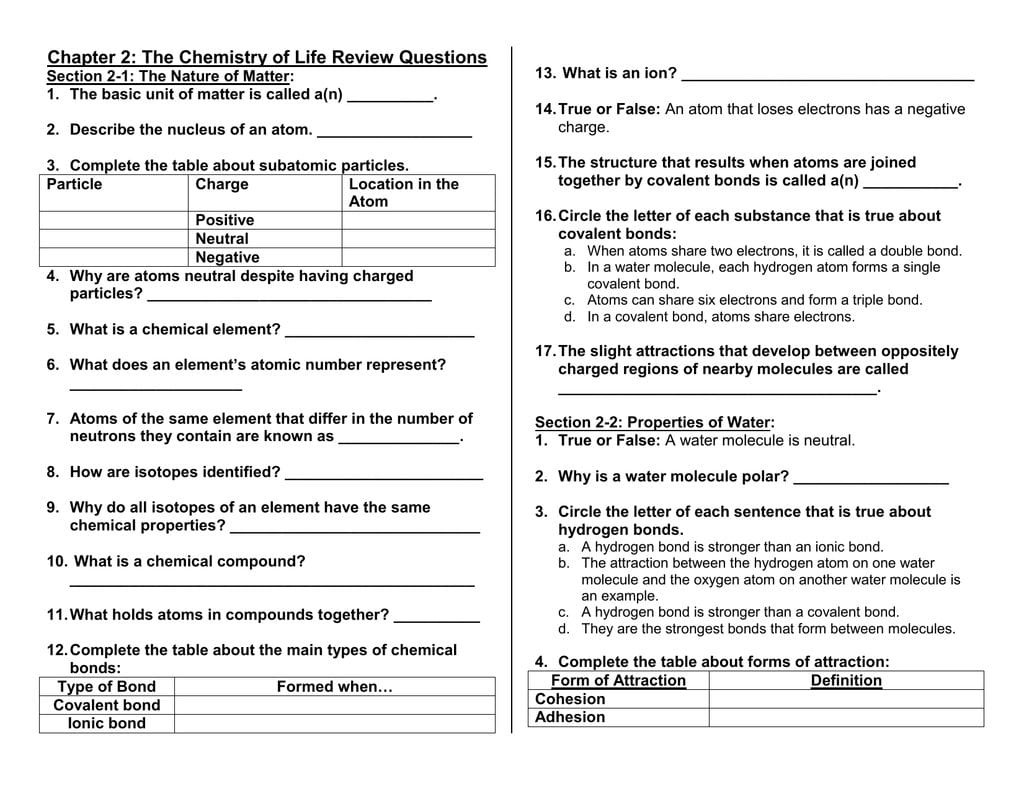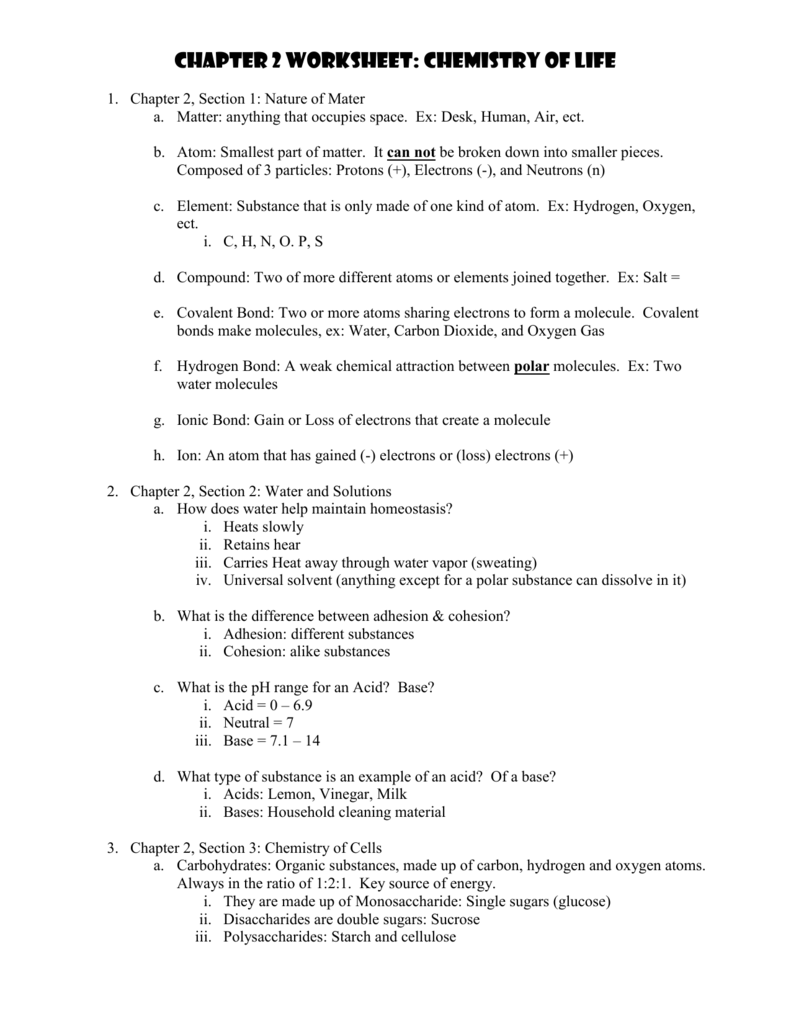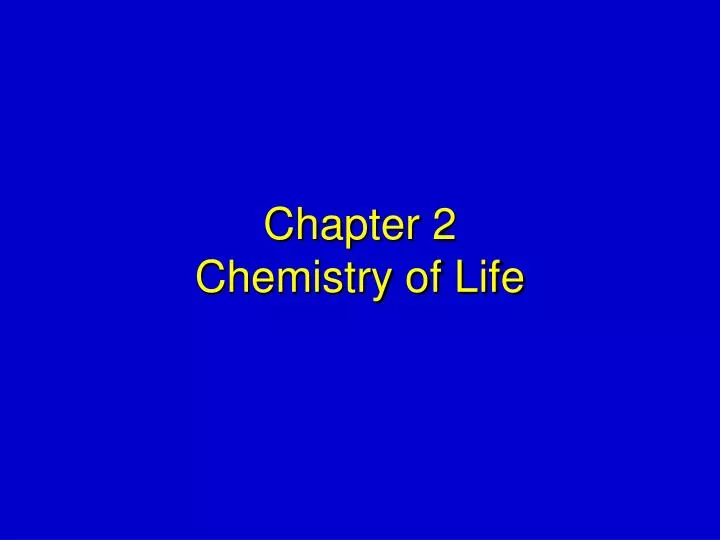Chapter 2 Chemistry Of Life Answer Key
Chapter 2 Chemistry Of Life Answer Key - Answer key 1 chapter 2 chemistry of life test answer key. 2 o, nacl, oh, no 3, po. Web chapter 2 big idea: The basic unit of matter. Protons neutrons electrons why do isotopes of the same element have the same chemical properties? Web the subatomic particles that make up atoms are protons, neutrons, and electrons. How do chemicals combine and break apart inside living things? The answer key provides clear explanations of these. Introduction to the chemistry of life. Web 1 / 85 flashcards created by dillypapa chapter 2 the chemistry of life study guide terms in this set (85) the main source of energy for living things carbohydrates help carry out chemical reactions proteins.
Answer key 1 chapter 2 chemistry of life test answer key. A variant form of an atom. We next provide the overview of silicon chemistry section 3. How do chemicals combine and break apart inside living things? Web chapter 2 chemistry of life test answer key. Important parts of biological membranes. The elements carbon, hydrogen, nitrogen, oxygen, sulfur, and phosphorus are the key. A 6 chapter 2 chemistry of life test answer key. Web chapter 2 big idea: Figure 2.1 foods such as bread, fruit, and cheese are rich sources of biological macromolecules.
Why are the properties of water important to organisms? Web key, illustrates the most current scientific knowledge and makes the information more accessible. The center of the atom that is formed by protons and neutrons bound together with strong forces. Web learn test match created by abtastic2020 terms in this set (83) the three particles that make up an atom are a) protons, neutrons, and isotopes b) neutrons, isotopes and electrons c) positive, negatives, and. How do organisms use different types of carbon compounds? Web the main source of energy for living things. The elements carbon, hydrogen, nitrogen, oxygen, sulfur, and phosphorus are the key. A variant form of an atom. Matter and energy 2.1 gq: Answer key 1 chapter 2 chemistry of life test answer key.
Biology Chapter 2 The Chemistry Of Life Study Guide Study Poster
4 the physical and chemical properties of a compound are usually very different from those of the elements from which it is formed. The center of the atom that is formed by protons and neutrons bound together with strong forces. The basic unit of matter. Web substance formed by the chemical combination of 2 or more elements. The answer key.
Biology Chapter 2 The Chemistry Of Life Worksheet Answers —
The amount of energy associated with the movement of the atoms and molecules in a body of matter. The elements carbon, hydrogen, nitrogen, oxygen, sulfur, and phosphorus are the key. Why are the properties of water important to organisms? One particular type of atom which cannot be broken down into simpler substances. We then discuss how silicon chemistry meets the.
Chemistry of Life Study Guide Answer Key Ion Chemical Elements
Web learn test match created by abtastic2020 terms in this set (83) the three particles that make up an atom are a) protons, neutrons, and isotopes b) neutrons, isotopes and electrons c) positive, negatives, and. Contain hydrogen, oxygen, nitrogen, phosphorus,. What is the matter in organisms made of? Important parts of biological membranes. Web an atom or molecule that has.
Chapter 2 The Chemistry Of Life Review Questions —
4 the physical and chemical properties of a compound are usually very different from those of the elements from which it is formed. Protons neutrons electrons why do isotopes of the same element have the same chemical properties? Important parts of biological membranes. Web chapter 2 the chemistry of life concept map answer key | metro map. Web 1 /.
Chapter 2 Chemical Basis Of Life Study Guide Answers Study Poster
This is due to their greater concentration of h ions than pure water. Web key, illustrates the most current scientific knowledge and makes the information more accessible. We then discuss how silicon chemistry meets the requirements for the chemistry of life,. Web an atom or molecule that has gained or lost one or more electrons. The amount of energy associated.
Unit 5 Test Review Biology Answer Key / Cells The Units Of Life
The elements carbon, hydrogen, nitrogen, oxygen, sulfur, and phosphorus are the key. 4 the physical and chemical properties of a compound are usually very different from those of the elements from which it is formed. Web the subatomic particles that make up atoms are protons, neutrons, and electrons. The answer key provides clear explanations of these. Web the first section.
chapter 2 The chemistry of life Crossword WordMint
What is the matter in organisms made of? Web chapter 2 the chemistry of life concept map answer key | metro map. We next provide the overview of silicon chemistry section 3. We then discuss how silicon chemistry meets the requirements for the chemistry of life,. Because they have the same # of electrons what are the main types of.
12th class Solution Chapter 2 Chemistry handwritten notes pdf here by
Web chapter 2 chemistry of life test answer key. A 6 chapter 2 chemistry of life test answer key. How do chemicals combine and break apart inside living things? Web substance formed by the chemical combination of 2 or more elements. The chapter describes biochemical compounds and reactions as well as the significance of water to life.
chapter 2 The chemistry of life Crossword WordMint
2 o, nacl, oh, no 3, po. Introduction to the chemistry of life. The amount of energy associated with the movement of the atoms and molecules in a body of matter. How do chemicals combine and break apart inside living things? Web learn test match created by abtastic2020 terms in this set (83) the three particles that make up an.
PPT Chapter 2 Chemistry of Life PowerPoint Presentation, free
The basic unit of matter. Web chapter 2 chemistry of life test answer key. What is the matter in organisms made of? We then discuss how silicon chemistry meets the requirements for the chemistry of life,. Why are the properties of water important to organisms?
The Elements Carbon, Hydrogen, Nitrogen, Oxygen, Sulfur, And Phosphorus Are The Key.
It covers topics such as atoms, elements, and compounds. Web an atom or molecule that has gained or lost one or more electrons. Important parts of biological membranes. Web chapter 2 big idea:
Smallest Basic Unit Of Live.
Help carry out chemical reactions. The center of the atom that is formed by protons and neutrons bound together with strong forces. This dna molecules, like all molecules, is made up of atoms joined together in bonds. What is the matter in organisms made of?
Web Learn Test Match Created By Blakebahos32 Terms In This Set (72) What Are The Subatomic Particles That Make Up An Atom?
Web 1 / 85 flashcards created by dillypapa chapter 2 the chemistry of life study guide terms in this set (85) the main source of energy for living things carbohydrates help carry out chemical reactions proteins. Protons neutrons electrons why do isotopes of the same element have the same chemical properties? 2 o, nacl, oh, no 3, po. Web chapter 2 the chemistry of life concept map answer key | metro map.
Web The Subatomic Particles That Make Up Atoms Are Protons, Neutrons, And Electrons.
We then discuss how silicon chemistry meets the requirements for the chemistry of life,. In this model, the atoms are carbon (black), oxygen (red),. Web chapter 2 chemistry of life test answer key. Web learn test match created by abtastic2020 terms in this set (83) the three particles that make up an atom are a) protons, neutrons, and isotopes b) neutrons, isotopes and electrons c) positive, negatives, and.









